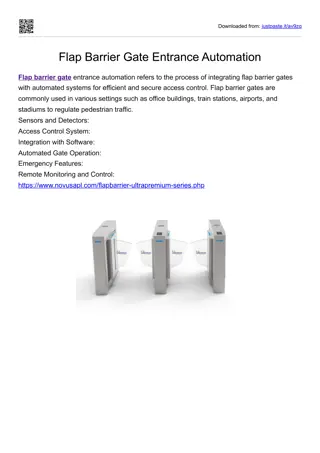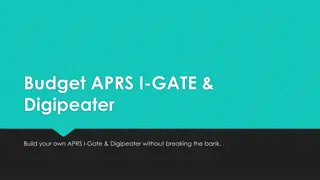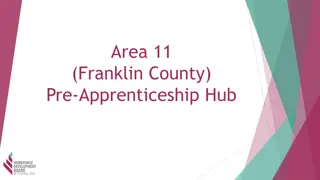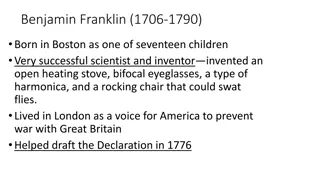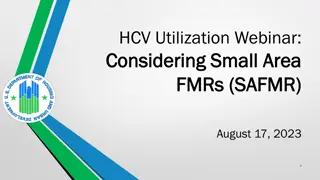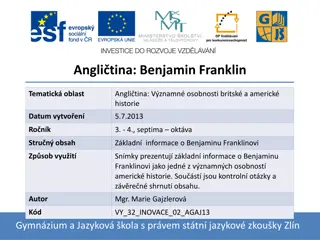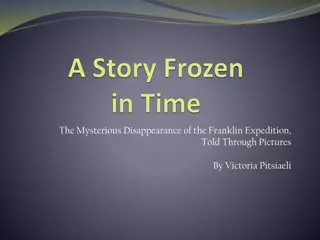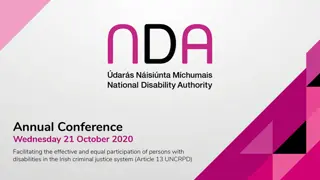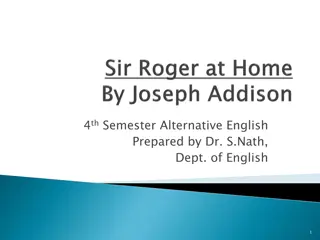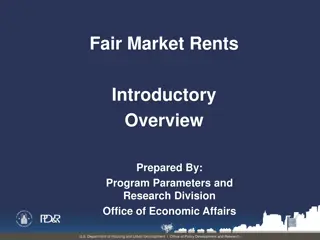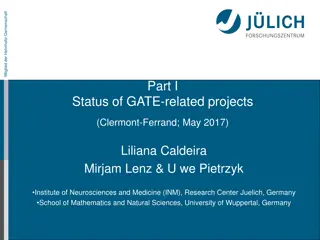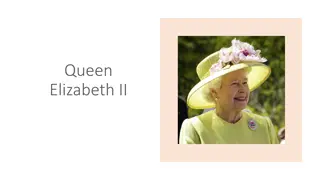
Tertiary Education in Trinidad and Tobago
Explore the development of tertiary education in Trinidad and Tobago through initiatives like the GATE Programme, focusing on goals, participation rates, funding, and impact on private institutions. The nature of Tertiary Level Education (TLE) as a public good is also discussed, highlighting its characteristics of non-excludability and non-rivalry.
Download Presentation

Please find below an Image/Link to download the presentation.
The content on the website is provided AS IS for your information and personal use only. It may not be sold, licensed, or shared on other websites without obtaining consent from the author. If you encounter any issues during the download, it is possible that the publisher has removed the file from their server.
You are allowed to download the files provided on this website for personal or commercial use, subject to the condition that they are used lawfully. All files are the property of their respective owners.
The content on the website is provided AS IS for your information and personal use only. It may not be sold, licensed, or shared on other websites without obtaining consent from the author.
E N D
Presentation Transcript
Elizabeth Ince, Roger Elizabeth Ince, Roger Hosein Hosein, , Martin Franklin Martin Franklin 1
2004: GATE Programme 50% Tuition Funding + Up to 100% Tuition Funding based on Means Test 2006: GATE Programme Modified 100% Universal Tuition Funding for persons wishing to pursue TLE 2001: Dollar for Dollar programme 50% TLE Tuition Funding 2
One of the major goals created for the GATE programme was the attainment of a tertiary participation rate of 60% by 2015. By 2008, the tertiary participation rate within Trinidad and Tobago had increased to 40% (Trinidad and Tobago International Financial Centre). By 2012, the tertiary participation rate stood at 46% (Ministry of Tertiary Education and Skills Training, 2012). In addition to the increase in the tertiary participation rate, the introduction of the GATE Programme brought with it a mushrooming of private tertiary level institutions. 3
Total Expenditure $TT (Millions) Fiscal Year Private Institutions Public Institutions Number of Students Receiving GATE Funding 2004/2005 30 72 27,214 2005/2006 70 110 38,669 2006/2007 244 229 57,328 2007/2008 232 270 53,437 2008/2009 240 335 52,822 2009/2010 236 349 53,711 2010/2011 281 344 45,040 Report of the Standing Committee on the GATE Programme (2011) 4
Defining the Nature of the good TLE 5
Function Function of of Higher Higher Education Education Non Non- -Excludability Excludability Non Non- -Rivalry Rivalry Teaching Does of non-excludability since it is possible to bar the entry of students willingness to pay. Does not not have have the characteristic Has rivalry since the presence of an additional student does not reduce the ability to learn of another. Has the characteristic of non- based on their Research Does of persons may be prevented from accessing knowledge through the use of patents or making research private. Does not not have non-excludability have the characteristic Has rivalry since if an additional person knowledge, it does not reduce the ability of another to benefit from the same knowledge. Has the characteristic of non- since benefits from Provision of services Does of access will be limited based on willingness to pay for the service. Does not not have non-excludability have the characteristic Does of non-rivalry since only the person/persons interacting with the TLI s representative will benefit from the service at one time. Also, an additional cost will be attached if another person were to benefit from the service. Does not not have have the characteristic since 6
Table 1: Key Macroeconomic Indicators for Trinidad and Tobago, 1999 2009 Year GDP TT$ m 2000= Table 1: Key Macroeconomic Indicators for Trinidad and Tobago, 1999- -2001 and 2001 and 2009- -2011p. Inflation Rate (%) 2011p. Crude production (000 barrels per day) Real Growth Rate of Real GDP (%) Unemp loyme nt Rate (%) oil Price per barrel of crude oil (US$) West Texas Intermedi ate 17.7 Petroleu m Industries Contribut ion GDP TT$mn (b) 14302.2 Natur al Gas Prices Reserve to Producti on Ratio Year to 100 1999 45978.6 4.4 13.2 3.4 126.8 2.08 15.1 2000 49335.1 7.3 12.2 3.5 130.5 29.0 16072.8 2.27 16.4 2001 51447.2 4.3 10.8 5.6 113.5 19.8 16920.5 4.23 19.9 -3.5 8.1 2009 88744.5 5.5 12.2 163.3 53.56 37582.1 8.85 -1.2 8.0 2010 90975.1 6.4 10.5 152.4 71.21 38625.0 3.89 -1.4 8.1 2011p 88060.8 6.3 2.7 91.92 83.00 38281.4 4.39 7
Horizontal Efficiency vs Vertical Inefficiency 8
Figure 1: Intended Policy Influence of GATE AS1LR AS0LR AS0SR $P AS1SR ? P0 ? AD1 AD0 0 Y0 Y1 Y 9
Figure 2: Effect of Oil Windfall GATE on Income of Households Pursuing TLE Income of Households YrG Yr B YGd Ym A Yp Y1d 0 Hr Financial Need Hm Hp 10
Case study of Trinidad and Tobago 11
Income Group (TT$) Average Size of % Accessing GATE Percentage Number of Average Monthly Household by Funding by Income Distribution of Households by Savings per Income Group of Group of Head households by Household Income household by Head Household Income Group Household Income Group Group All Income Groups 3.4 0.9 100.0 7,090 $1033.60 Less than 1,000 3.8 0.5 2.0 $114.10 142 1,000-2,999 3.1 0.2 10.4 $298.50 737 3,000-4,999 3.3 0.3 17.0 $292.90 1,205 5,000-6,999 3.4 1 17.2 $503.40 1,219 7,000-8,999 3.5 1.8 14.0 $767.50 993 3.4 4.6 11.7 $981.20 9,000-10,999 830 3.3 2.9 7.6 $1389.50 11,000-12,999 539 3.3 5.5 5.2 $1706.70 13,000-14,999 369 3.3 1.5 3.9 $1894.40 15,000-16,999 277 3.3 7.9 2.9 $2110.60 17,000-18,999 206 19,000-20,999 4.1 0 2.1 $2256.80 149 21,000-22,999 4.1 0 1.5 $3418.00 106 23,000-24,999 2.9 0 0.9 $3293.80 64 25,000 and Over 3.2 5 3.6 $5079.90 255 Source: Trinidad and Tobago Household Budget Survey 2008/09 *7,090 Households Participated in this Survey 12 7,090 Households Participated in this Survey
The True Proportion Needing Financial Assistance 13
Calculation of persons financial need, with respect to the amount needed to fund TLE, reveals the extent of their financial need based on their per capita income in comparison to the average national per capita income of Trinidad and Tobago. The financial need gap is calculated using the national income per capita (Yn) in comparison to the actual average per capita income (Yi) of households, as can be found in the Household Budget Survey Financial Need = 14
Average Monthly Savings per Household by Income Income Group by Head (TT$) Per Monthly Household Income Capita Financial Index Need Average Monthly University Fees Student Average Monthly Capita Household Income Average Monthly University Fees per (Yn - Yi)/Yn per And All Income Groups <1000 1000-2999 3000-4999 5000-6999 7000-8999 9000-10999 11000-12999 13000-14999 15000-16999 17000-18999 19000-20999 21000-22999 23000-24999 >25000 $2,744 $125 $930 $1,467 $1,943 $2,300 $2,697 $3,049 $3,447 $3,857 $4,525 $4,755 $4,917 $5,390 $7,911 $1,034 $114 $299 $293 $503 $768 $981 $1,390 $1,707 $1,894 $2,111 $2,257 $3,418 $3,294 $5,080 0.95 0.66 0.47 0.29 0.16 0.02 0.00 0.00 0.00 0.00 0.00 0.00 0.00 0.00 $623 $623 $623 $623 $623 $623 $623 $623 $623 $623 $623 $623 $623 $623 $748 $1,553 $2,090 $2,567 $2,923 $3,320 $3,672 $4,071 $4,481 $5,149 $5,378 $5,541 $6,014 $8,534 15
Application to Trinidad and Tobago Application to Trinidad and Tobago 16
Figure 3: Illustration of Income-contingent payments with a subsidised interest rate Loan Amount S(i,y) D*L (X0)*p = PV of loan Present value of payments X0 Accumulated income during life of contract Source: Adapted from Investing in Human Capital (Palacios Lleras, 2004,pg 178) 17
Students repayment is contingent upon future income. Therefore, those benefitting less from their investment in TLE are effectively subsidised. Repayment commences only after graduate reaches a certain income threshold. Maximum repayment by the graduate is equal to the original value of the loan in present value terms. Can include a maximum repayment period after which the loan is forgiven. Equitable form of student loans Benefits students of all income brackets 18
Percent % Income Group Educational Attainment of Head Primary School School All Household Members 100 None Pre- School Secondary University Other N/A Not Stated All Groups None Less 1000 1000-2999 3000-4999 5000-6999 7000-8999 9000-10999 11000-12999 Income 100 100 100 100 100 100 100 100 32.3 5.4 32.5 6.0 29.6 6.2 26.3 6.2 36.3 5.4 30.5 3.2 26.7 3.1 80.0 80.0 45.8 6.8 than 22.8 17.9 10.1 4.9 2.7 1.5 50.4 6.4 2.1 2.1 0.4 0.0 39.5 17.3 1.2 4.9 0.0 0.0 37.2 18.5 6.7 2.8 1.1 0.4 17.2 19.0 11.6 5.0 2.5 1.2 5.3 8.3 12.4 10.4 9.5 6.7 14.3 18.7 13.4 9.1 5.3 3.5 20.0 0.0 0.0 0.0 0.0 0.0 20.3 16.9 6.8 1.7 0.0 1.7 13000-14999 0.8 0.0 0.0 0.3 0.6 3.4 2.1 0.0 0.0 15000-16999 0.5 0.0 1.2 0.2 0.4 2.7 1.4 0.0 0.0 17000-18999 0.3 0.0 0.0 0.1 0.3 1.7 0.7 0.0 0.0 19000-20999 0.2 0.0 0.0 0.1 0.1 1.0 0.5 0.0 0.0 21000-22999 0.1 0.0 0.0 0.1 0.1 0.5 0.2 0.0 0.0 23000-24999 0.1 0.0 0.0 0.0 0.0 1.0 0.1 0.0 0.0 25000 Over and 0.4 0.0 0.0 0.0 0.2 3.4 0.8 0.0 0.0 19
Aspect of Deferred Scheme Income Thresholds and Percentage of Salary to be Repaid Repayment Collection System Interest Rate Discount Rate Maximum Duration of Loan Alternative Repayment Options Aspect of Deferred Payment Scheme Payment Application Tobago $7,000 3%; $13,000 5%; $21,000 8% Board of Inland Revenue Reflects yearly inflation 20% off Up-Front Tuition 25 years Repayment of full loan at any point in time. Conversion to traditional bank loan with market based interest rate. Application in Trinidad and Tobago in Trinidad and NB: The proposed ICL structure is a work in progress. 20
Universal education within Trinidad and Tobago is an inefficient use of rents from the sale of petroleum as can be seen in the: Review of the 2008/09 Household Budget Survey Review of the Financial Need of Households with persons pursuing TLE Use of an Income-Contingent Loan efficiently subsidises the merit good TLE for students. subsidising of tertiary level 21
Thank you. 22

